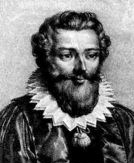

François Viète attended school in Fontenay-le-Comte, and then educated at the University of Poitiers. After graduating with a law degree in 1560, Viète entered the legal profession, but he only worked 4 years before deciding to change his career. For two years he supervised the education of Catherine of Parthenay.
Viète lived a very politcal life. In 1573, Charles IX appointed him to the government of Brittany. In 1580, Henry III appointed him royal privy counsellor, and he was attached to the parliament in Paris. In 1584 his position as a known Huguenot became untenable and he was banished by his political enemies from the court. Although he was never employed as a professional scientist or mathematician, Viète was already working on topics in mathematics and astronomy.
Viète went to Beauvoir-sur-Mer. During the 5 years that he spent there, he was able to devote himself entirely to his mathematical studies, and it was during
this period that his most important mathematics was done.
In 1587, Henry of Navarre brought him back into his parliament. After two assassinations, Viète worked for Henry IV decoding messages from other leaders. He was certainly well known for his mathematical abilities by this time. Viète occasionally lectured on mathematics. In 1592 he lectured and debunked claims that the circle could be squared, an angle trisected, and the cube doubled using only ruler and compass.
Viète introduced the first systematic algebraic notation in his book In artem analyticam isagoge, published in 1591. He demonstrated the value of symbols introducing letters to represent unknowns. He suggested using letters as
symbols for quantities, both known and unknown. He used vowels for the unknowns and consonants for known quantities. The convention where letters near the
beginning of the alphabet represent known quantities while letters near the end represent unknown quantities was introduced later by Descartes.
Viète also made many improvements in the theory of equations.
He presented methods for solving equations of second, third and fourth degree. He knew the connection between the positive roots of equations and the
coefficients of the different powers of the unknown quantity. Perhaps it is worth noting that the word "coefficient" is actually due to Viète. When he applied
numerical methods to solve equations, he gave methods which were similar to those given by earlier Arabic mathematicians.
Viète also wrote books on trigonometry and geometry, in which he gave geometrical solutions to doubling a cube and trisecting an angle and the construction of the tangent at any point on an Archimedian spiral. He also calculated pi to 10 places using a polygon of 393216 sides. He also represented pi as an infinite product for the first time.